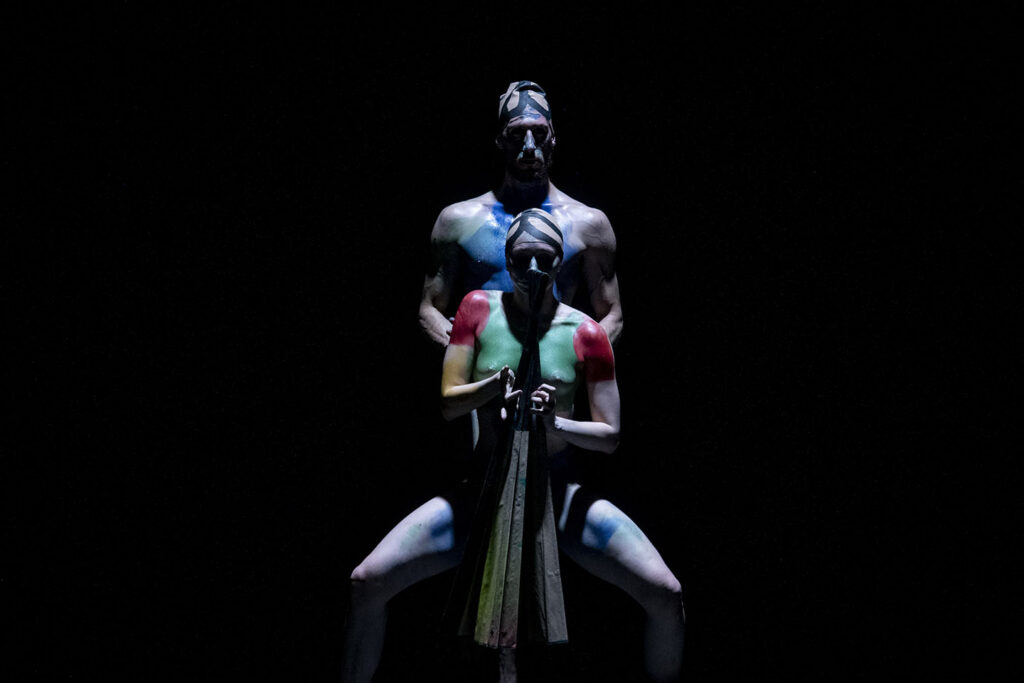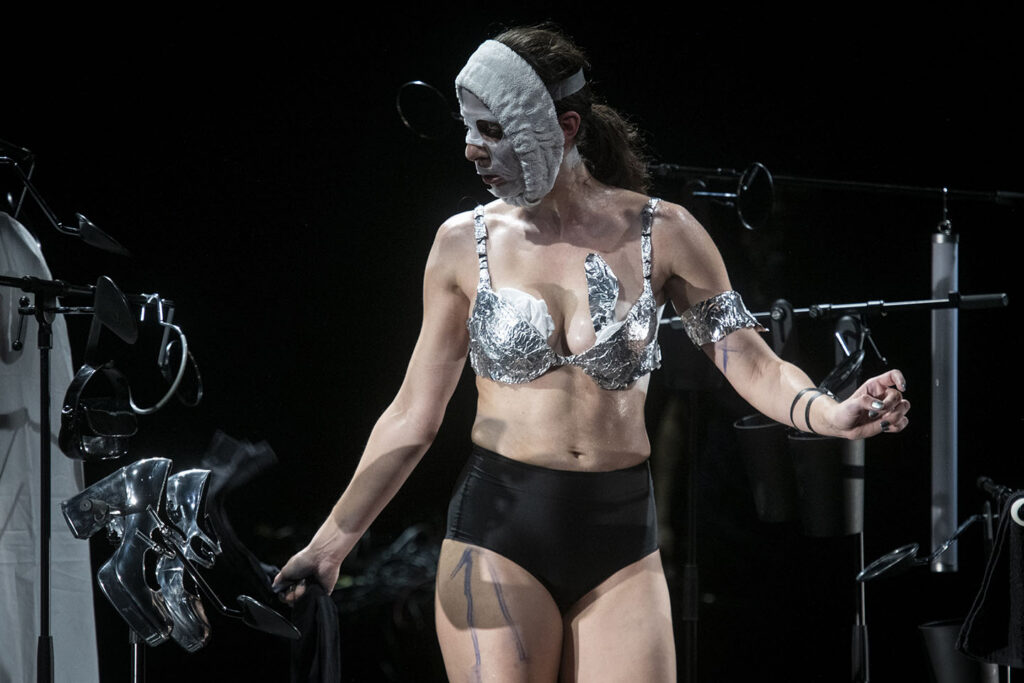
We live in an age of augmentation – an era where people can reshape their bodies and identities in countless ways: through bold fashion, plastic surgery, or by crafting exaggerated personas in the digital realm. This contemporary fascination with transformation, and going beyond the human, was one of the strongest themes to emerge at the inaugural Moving Balkans platform. Six out of ten works featured moments that altered, extended, or abstracted the bodies of their performers in different ways, and to different effects.
Adding on to distort outline
German choreographer Oskar Schlemmer, a key figure of the Bauhaus movement, is best known for his seminal work The Triadic Ballet. Featuring dancers in outlandish costumes that obscure their physical features, the 1922 work playfully transforms their bodies into abstract triangles, circles, and spheres.
Hungarian choreographers Emese Cuhorka and Csaba Molnár’s Masterwork for Six Dancers, performed at Moving Balkans by Slovenian company En-Knap, directly cites Schlemmer’s work as inspiration. The comparison is clear. Starting off the piece nude, their bodies painted in bright Bauhaus primary colours that dissect their forms into geometric shapes, the cast later retrieve yoga mats, wrapping them around their bodies to create cylindrical forms; insert sticks through large t-shirts to extend and square out their shoulders; and encase themselves in fabric tubes, evoking both cocooned butterflies and Martha Graham’s iconic Lamentation. Each costume has a unique effect on their movement qualities, provoking humorous hops and topples across the stage as they become accustomed to their new corpuses.
These experimentations with the human form are largely whimsical: to repeat the image I used in my 3-sentence review of Masterwork [LINK], they appear like children pulling different objects out of a toybox, exploring how they can use them to fuel imaginative games and create fantastical worlds.
Greek choreographer Patricia Apergi’s The House of Trouble similarly features performers distorting their silhouettes using a range of costume elements – from metallic triangle bras to large coiled wire structures that encircle their upper and lower bodies, adorned with flowers and other accoutrements. Yet as they march and swagger across the stage in runway-like formations, their bodies refracted in the metallic balloons that line the stage’s walls, these transformations seem less rooted in childlike play than the performative, identity-shaping power of fashion. It’s a fitting parallel: one dance style Apergi drew on for her work was voguing, a subcultural form from 1980s New York inspired in large part by the gestures and poses found in fashion magazines.

Experimenting with identity and appearance through beauty rituals can be fun. I myself love red lipstick. Despite ex-boyfriends telling me I don’t need it, I keep wearing it because it makes me feel confident and in control. But when these modifications are driven by external pressures rather than personal choice, their effects can become destructive. This seems to be the case for Kosari: throughout Runway, it’s not her own desire that drives her bodily augmentation, but a disembodied, airport-style announcer voice spewing harmful cliches about beauty and appearance that drives her actions. This metamorphosis isn’t self-expression, it’s submission to a harmful ideal.
Stripping back to accentuate the alien
While adding objects onto the body may be the most easily effective way to alter its shape, Bulgarian choreographers Stanislav Rumenov Genadiev and Violeta Georgieva Vitanova’s Saline Nebula instead used nudity to transform their solo performer into an almost non-human entity.
Alone, atop what resembles a scientific specimen table, the dancer slowly writhes her naked limbs, covering them first in a salt-like powder, then in a glistening, gooey liquid. While her body initially reads as human, her face is obscured by a white mask adorned with what resemble bathroom suction cups, giving her an uncanny, almost Doctor Who-style creature appearance. Her slithering motions lend her a serpentine quality, showing how obscure, unpredictable movement – defying typical human pathways – can alone transform performers’ bodies into something unfamiliar.
Saline Nebula’s performer is strange enough to feel “other” and human enough to evoke empathy. In more panicked moments, she anxiously twitches her head and looks around her as if unsettled by finding herself alone and isolated in this sterile, unknown environment. It prompts an interesting question: Can we only truly feel empathy for other species when we can recognize something of ourselves in them?
Body becomes digital
In Screenagers (Vol. 2), Croatian choreographer and performer Barbara Matijević doesn’t merely add to or subtract from her body. Instead, she transports it – and those of her audience – into an entirely different realm.
Screenagers (Vol. 2) is concerned with how the internet has shaped our experiences and collective imagination, a theme that, for the most part, Matijević explores by playing a succession of nihilistic songs on her keytar, singing lyrics about the end of the world and how the internet constantly tells us we’re doing everything wrong.
But there’s more: Matijević holds a laptop against different parts of her body, aligning her limbs with videos of other limbs playing on the screen, creating the illusion that she’s disappearing into the laptop in an eerie blurring of virtual and real. Audience members are also encouraged to take out their phones in the auditorium – a theatrical taboo! – and connect to a specially created WiFi server. From there, they follow a link that lets them create a superhero-like avatar that appears on the back wall of the stage, and can be manipulated using simple up and down arrows.
In this moment, the audience’s minds and consciousness are transported out of their bodies, beyond the physical experience of being in the theatre. They become more focused on projected, pixelated representations of themselves than on engaging with the human body on stage – or even the bodies sitting right next to them. Later, viewers are invited to submit answers to questions that Matijević sings as part of one of her songs. As the answers appear on screen, audience members make their presence and ideas known – all without the need for a voice or a physical body to do so.
Those who struggle to join the server feel left out of the fun – an unexpected form of exclusion in a theatre, a space where one expects to watch live performances, not be glued to a smartphone. In this work, showing up physically is less important than being digitally visible. It’s a stark reminder of how, in an age when we’re supposedly more connected than ever, we can also end up feeling more disembodied, distracted, and alone.
Shapeshifting through a lifetime
While Taiwanese-Turkish performer Filiz Bozkuş Al is a master of metamorphosis, I almost didn’t think to include her in this roundup due to her distinctly different approach. Rather than trying to go beyond the human, she delves deeper into it, shapeshifting through the defining stages of human life in her solo GONG.
Most impressive is her portrayal of a newborn baby, a feat that could easily slip into caricature or parody if not handled with care. But Bozkuş Al’s performance is anything but superficial. Her intimately observed embodiment – the way she rolls her wrists, widens her eyes, stumbles over her limbs as if discovering them for the first time, and emits high pitched squeaks as if she’s not yet learned language – is utterly convincing. She’s not acting like a baby, she’s thinking like one, becoming her subject from the inside out. It’s reminiscent of Emma Stone’s portrayal of Bella Baxter in Yorgos Lanthimos’ 2023 film Poor Things, in which a grown woman is reanimated with the brain of an infant.
Later, Bozkuş Al transforms into a screaming, limb-flinging teenager – an angst that returns later in the piece. At first, it’s confusing, as if her character has regressed or the timeline has become tangled. When speaking with Bozkuş Al after the show, she says that these days we’re taught that everything needs to be perfect. To combat this, she wanted to depict how the journey of life isn’t linear – sometimes, we can have a death in the middle and need to be reborn.
“Before, mythological stories shared this with us,” Bozkuş Al says. “Now we’re [not so aware of it], they don’t teach us about it at school. Mathematics is not always enough for life,” she adds, echoing a sentiment I’m sure many arts educators facing depleting funding and enrolments to their subjects would recognise. “We are always faced with dragons and monsters in life. [Sometimes] we even become the monster or the dragons ourselves. But if we can be strong enough to hear our gong again, then we can again find something in life.”
Bozkuş Al’s work shows that while bodies can be augmented, disguised, or even digitised, metamorphosis remains an innately human act – one we carry within us through every stage of life, whether chosen or imposed, and whether it brings beauty, pain, or both.



